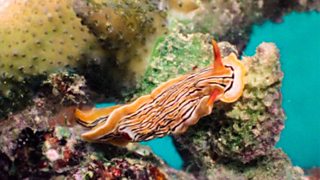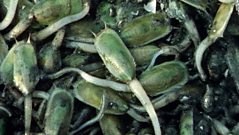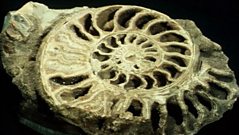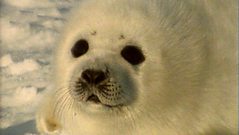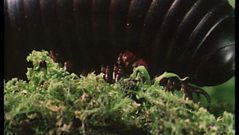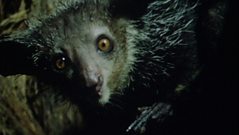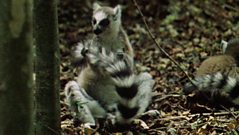
From feather stars to sea urchins: echinoderm evolution
David Attenborough looks at the evolutionary relationships among echinoderms.
David Attenborough looks at some flower-like fossils with radial symmetry.
Over a few millions years these developed into sea lilies or crinoids. The fossils are around 300 million years old but on the Barrier Reef some of their relatives - the feather stars - still flourish.
Feather stars are just like those ancient crinoids, but do not have stems except when they are very young.
The adults look just like plants but swim around freely, mostly at night, looking for feeding grounds where they can cling to the rocks and catch floating particles with their arms.
Their relatives - the starfish - show another characteristic of this group: their bodies have a five-fold symmetry. The mouth of a starfish is underneath it and it moves on thousands of tube feet, each of which has a suction pad on the end and each of which is operated by hydraulics as they are all connected to water-filled vessels that run throughout the body.
Their cousins, the brittle stars, are much speedier.
Sea urchins also have tube feet but move mainly with the help of their spines. Some of their tube-feet are specialised for different jobs such as moving bits of debris from around the mouth which, like that of the starfish, is on the underside of the animal.
Urchins graze on algae, using their hard jaws to gnaw the food and then excrete the remains from a hard pore on top. The spines are attached to the plates of the urchin's shell by ball-and-socket joints so they can move in any direction with the top spines used mainly for defence.
If a shadow falls across an urchin its spines will all point in that direction to thwart a possible attacker.
All these creatures may seem to be very different from the original crinoids but they all have a radial symmetry and tube feet.
Although we can not be sure of an evolutionary path, there do seem to be some relationships. For instance, if the head of a crinoid is dropped on its face it looks much like a starfish. This, thinned down, then looks like a brittle star. And if it thickens, turns its arms back in on itself, and grows spines, you then have a sea urchin.
One group of these became elongated, lay down on its side to feed, and became a sea cucumber. Most sea cucumbers use their tube feet to work their way along the sea floor, feeding on detritus. Despite there being 5,000 different species of echinoderms, none have evolved to be particularly swift or smart.
Duration:
This clip is from
Featured in...
![]()
大象传媒 Nature
Be captivated, informed and inspired by the world's wildlife.
More clips from Building Bodies
-
![]()
Living fossils
Duration: 01:13
-
![]()
Fossil detection
Duration: 03:42
More clips from Life on Earth
-
![]()
Lucky pups—The Rise of the Mammals
Duration: 03:29
-
![]()
Millennia of millipedes—The First Forests
Duration: 01:50
-
![]()
Creatures of the night—Life in the Trees
Duration: 01:16
-
![]()
Scent sense—Life in the Trees
Duration: 02:55
